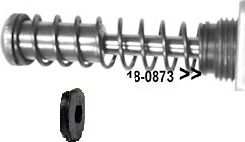How often would one have to adjust the slack out?
Well, see, that's the thing....no one knows, unless there's a Feejer pilot with a manual CCT running around somewhere.
The OEM adjusts all the time. Literally every time the bike is cranked and run, the OEM will, if the spring is strong enough, unwind a bit to take up slack so in theory, it's always on the job, from the day the bike is first started after assembly....to the day you airmail a set of valves courtesy of your pistons because the spring has no more tension.
From everything I've read on the issue on the Kawasaki forums, ZX9s and 10s are noted for auto CCT problems, when the you hear a chain noise, you snug it up. It's a very unscientific measurement. That's why the auto CCT is so ubiquitous. You don't HAVE to think about it, until your engine shreds.
But doing the math, the OEM has a 1.25 inches of travel. Many around the FJR forum are replacing CCTs in the 40-50k miles range, because the OEM is no longer taking up enough slack. So 17 divided by red, carry the tune, add a half of Bustanut....if you changed oil every 3000 miles, you'd adjust a manual 75 thousandths of an inch every oil change.
Honest, Toe, I don't think anyone can give an honest answer, other than "if it rattles, he will come".
The only thing I would stake my motor's life on is this....if you hear your cam chain begin to rattle...5k miles, 15k miles, 50k miles, ???k miles...that means only one thing -- the OEM is no longer providing enough spring force to properly retension the chain. Now, how long before certain death do you have to get it replaced? Alan reported noise beginning at 20k, louder at 34k and suicide at 40k. So in his case he had 20k miles before "bang".
I heard MY first death rattle 7k miles ago and did the "bump up the idle speed and forget it" boogie.
Kind of a wide sample, if ask me. 7k to 20k. At least it DOES mean once you hear the rattle of impending failure, you DO have SOME time to address the issue, either with an OEM replacement or installation of a manual.
The problem I have with the OEM is having to rely on such a small, featherweight spring to do the job. When did my spring break, allowing disaster? Was it 7k miles ago when I first heard the rattle? That CERTAINLY was the point where the tension was no longer adequate. Or did the spring break Wednesday night during my post-fuel-pump install warm-up, allowing the plunger to retract? Since my CCT was already marginal, given the chain clatter 7k miles earlier, maybe it did break during my first post-repair run and the plunger backed off JUST enough to allow the chain to jump ship.
Whatever, there's just too many variables, all with very expensive outcomes.
Re-reading my last several posts, yeah, I am a bit "down" on the OEM CCT. And maybe I'm overreacting. I'm curious to know what Alan thinks about the auto vs manual CCT situation. I'll never trust one again.
I took the time to disassmble the auto unit on my Kawi last night. It, too uses a spring to take up slack. But it's a "zero-return" design, using a ratchet and pawl system to prevent backing out. The plunger on a ZRX CAN'T come out on its own and if the chain gets noisy, that means the ratchet is "between" clicks and can manually be moved into the next lock-down position. THe FJR's CCT is NOT, I repeat NOT a "zero-return" design. In fact it IS designed to return, hence the return screw in the CCT body. But the only thing that prevents the plunger from returning on its own is the tension of the spring. That's seriously wrong.
































































